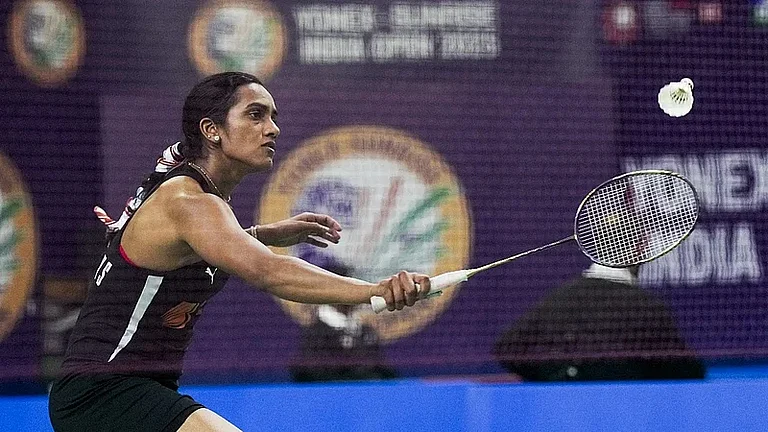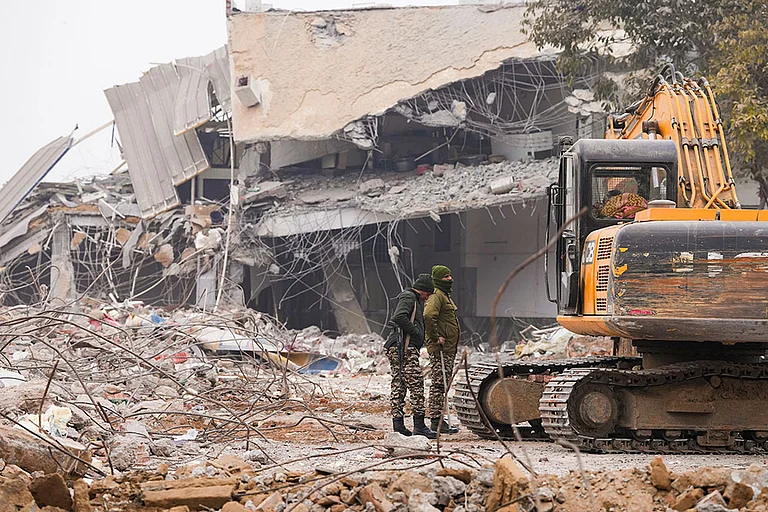The water of the Dal sparkles under the July sun; anchored shikaras bob up and down as gentle waves lap at the shores of the iconic lake in the capital of Jammu and Kashmir. Buses carrying pilgrims to the Hindu cave-shrine at Amarnath move along the boulevard that skirts Dal Lake; passengers peek out from the windows to click photographs on mobile phones as they soak in the beauty of the picture-postcard landscape. The buses are tucked in a military convoy—a long, winding row of diesel-powered vehicles carrying soldiers to this land of flaming-red chinar and snow-capped Himalayan peaks. It’s the land Mughal emperor Jahangir once famously described as the heaven on earth. It’s a paradise almost lost. It’s a paradise India seeks to regain.
For the BJP-led government led by Prime Minister Narendra Modi, Kashmir needs a closure as an “issue”—an unfinished story that dates back to the time when Maharaja Hari Singh signed an instrument in October 1947 to accede the Muslim-majority Kashmir Valley to India. Two wars with Pakistan and three decades of insurgency later, the government believes the time has come to achieve what successive governments had tried but failed. Into its second term with an overwhelming mandate, the Modi government wants to pull Kashmir out of its existing morass, break the status quo and integrate the Valley to the rest of the country. Even if it means shaking up the system and uprooting the old political order. On one hand, the government wants to handle terrorism with an iron hand and, on the other, it wants to improve governance at the grassroots level.
That Kashmir is at the centre-stage of the government’s agenda is quite evident from developments over the past few days. On Sunday, July 28, the Prime Minister, during his ‘Mann ki Baat’ address, talked about good governance and taking development to remote areas of Kashmir. The PM talked about the people of Kashmir being eager to join the mainstream, and that their enthusiasm is reflected in the success of the government’s community mobilisation programme ‘Back to Village’. National Security Advisor (NSA) Ajit Doval spent three days in the state, soon after which an order to send 10,000 additional central troops was issued by the Amit Shah-led home ministry. Separatist leaders claim that Kashmir already has an estimated seven lakh security personnel, including those of the state police, making the Valley one of the “most militarised zones” in the world.

Union home minister chairs a meeting in Srinagar to review security arrangements for Amarnath Yatra.
President’s rule in the state was extended by another six months through the first legislative proposal moved by Shah in Parliament. During the heated discussion in Lok Sabha, the home minister did give a peek into the plan as he spoke of devolution of powers and strengthening grassroots democracy in the state. “There is a fatigue factor among local people and they want peace and development. This is the ideal time to initiate anything,” says Governor Satya Pal Malik, who is convinced that now is the right time to work out a lasting solution to the imbroglio (See interview).
A senior official in the country’s security establishment says that the muscular policy of the government has started to show positive results, including a marked fall in infiltration of militants through the Line of Control (LoC), the de facto border with Pakistan. “Elections to local bodies and panchayats have been successfully held. Amarnath Yatra is being conducted peacefully with a record number of pilgrims taking part. Cross-border infiltration has been among the lowest in the first six months of 2019. Preparations are on for assembly elections later this year.”
Security officials also point to a dip in insurgency and civilian protests since the large-scale and prolonged period of violence that rocked the Valley following the killing of Hijbul Mujahideen commander Burhan Wani, a young engineering dropout who had become the poster-boy of militancy. His gunning down in July 2016 had sparked months of street-clashes between civilians and security forces, leaving more than a 100 people dead and more than a thousand injured. In June this year, security forces also eliminated Zakir Musa, who had succeeded Wani as the Hizb commander. The rise of Musa had pointed to a radicalisation of Kashmir’s militancy as he had publicly acknowledged the “religious” nature of insurgency and even accused Pakistan of betraying the ‘jihad’ in Kashmir.
The government and security agencies believe that these “minor irritants” have been removed and integration of Kashmir and Kashmiris is the logical conclusion. To begin with, the BJP plans to unfurl the Indian Tricolour in all recently-elected panchayats on August 15. BJP-friendly candidates won over 4,000 seats as the local political parties, the National Conference (NC) and Peoples Democratic Party (PDP), boycotted the elections. BJP leaders say that the additional troops have been sent to the Valley to provide security to the newly-elected panchayat chiefs as they put the stamp of their allegiance to the Indian Republic.
The order to move additional troops into Kashmir have sent rumours flying thick and fast in the Valley that is used to expecting the worst—Is there a threat of a terror attack? Is the government planning to abrogate Article 370 or annul Article 35A? Local leaders of the Valley, including Omar Abdullah, Mehbooba Mufti, Sajad Gani Lone and newcomer Shah Faesal, have cautioned against any “misadventure” by the Centre. As Outlook spoke to officers in the security establishment, the government and the BJP, the different pieces of a jigsaw puzzle appear to be falling into place, giving shape to the big J&K plan that includes administrative, political and constitutional shake-up, in addition to the continued clampdown on terrorism.
Delimitation plans
Will the state be trifurcated to carve out three separate Union territories—Jammu, Kashmir and Ladakh? Many in the state and outside say it is under consideration of the BJP-led government, though security experts view it as “too radical”. Seshadri Chari, an expert in strategic studies and a veteran RSS functionary, also believes that delimitation could be a less drastic option and the government may not go in for trifurcation. A section in the BJP believes that at present the entire focus is on Kashmir and trifurcation will end the discrimination faced by Hindu-dominated Jammu and Buddhist-majority Ladakh.
Separating Kashmir will also restrict the area of terrorism to the Valley. A better option, according to Chari, is to give greater autonomy to Leh and Ladakh. “The BJP needs to win back the Buddhist and Shia votes of the region. It was always a Shia-dominated area but gradually the Sunni vote bank became powerful due to calculated moves by certain groups. That’s why BJP could not win elections here,” he says.
This is where lies the germ of delimitation—an exercise through which the boundaries of an assembly or parliamentary constituencies is fixed or redrawn. What has angered political parties of Kashmir is the fact that the BJP is toying with the idea of delimitation in the state when there is an all-India freeze on such an exercise till 2026. The BJP, however, is of the view that the existing assembly structure in the state gives an “unfair advantage” to Kashmir over Jammu and Ladakh. Kashmir comprises 46 assembly seats, while Jammu and Ladakh comprise 37 and four, respectively (See Valley of Shadows).
There is a strong belief that giving more seats to Jammu could end the primacy of the Valley in elections; any party which can sweep Jammu in the hustings will be in a position to form the government in the state. The BJP, of late, has also made a case for electing the state’s first “Hindu chief minister”. Incidentally, as many as 24 assembly constituencies of the state are in Pakistan-occupied Kashmir (PoK) and the state BJP wants eight seats from PoK to be “defreezed” for refugees from the Pakistan-held region. Most of these refugees are settled in Jammu.
“Delimitation is bound to raise counter-arguments of changing demography and Hindu vote-bank. There is a danger of isolating the Valley further, rather than integrating it with the mainstream,” says an expert in strategic affairs. He gives the example of Pakistan bifurcating Northern Areas into Gilgit and Baltistan without any positive outcome. The J&K governor, however, believes that delimitation is a long-overdue requirement.
For the Valley, Chari suggests a “blow-hot-blow-cold” strategy to try and get some separatists also into the mainstream. “Terrorism is also a business with no ideology. It’s the same with Maoists. They have all become mercenaries. They may join whoever gives them money. I won’t be surprised if the BJP wins some seats in the Valley too when elections are held there next,” the former editor of Organiser says.
Some winds of change can already be felt in Kashmir. Separatist leaders like Mirwaiz Umar Farooq are no longer calling for ‘azadi’ during his Friday sermons. Instead, he is now raising social and environmental issues—talking about development, tackling drug abuse and preventing floods. He is also a part of a coordination committee trying to work out a plan for the return of Kashmiri Pandits who were forced to flee the Valley 30 years ago. Even hardline separatist Syed Ali Geelani did not give his mandatory call for a shutdown during Amit Shah’s first visit to Kashmir this June-end.
Articles of contention
For long, the BJP has aggressively pushed for scrapping Article 370 and Article 35A which give special status to the state, even putting them in its election manifestoes. Sources tell Outlook that the government is more focused on doing away with Article 35A which the ruling party views as “discriminatory against non-permanent residents and women of J&K” and as “an obstacle in development of the state.” Though Article 370 has been put on the backburner for the time being, the government may leave it to the Supreme Court to take a call on Article 35A, since it is hearing a petition on the article.
“The question of Articles 370 and 35A is sub judice, therefore the government should refrain from politicking over them. Also, trifurcation will divide the state along religious lines, something that will be harmful in the long run,” says NC leader and former chief minister Omar Abdullah, who also warns that “any misadventure by the Centre will set the state on fire”.
Lt General (retired) D.S. Hooda, a former Northern Army commander under whom the 2016 surgical strikes were carried out after the Uri terrorist attack, is also not sure if the time is ripe for measures like delimitation or doing away with the contentious articles of the Constitution. However, he believes that it will be better if Article 35A is struck down legally. “That’s a better approach rather than making it a political issue,” he tells Outlook.
The Congress, for one, has been highly critical of the Modi government’s hardline approach in dealing with Kashmir and its attempts to tinker with the state’s special status. Terming the government’s Kashmir plan as a “pipedream”, Congress leader Manish Tewari says that if the government tries to delete any of the legal provisions like Article 370 or 35A, it will open up a Pandora’s Box and create a situation that might be difficult to contain. “The BJP is under the mistaken belief that use of hard power alone can solve Kashmir. It is a political issue with security and cross-border dimensions,” he says.
Reforms agenda
The government, however, knows that Kashmir can be won only if the Kashmiris are on its side. With this agenda, the focus is on delivery of basic services to the people and weeding out corruption, which the government says is rampant. Transfer and management of development funds have been streamlined with a new method called the Budget Estimation and Management System (BEAMS). An anti-corruption bureau has also been established in the state for the first time with six new police stations under its jurisdiction. The “clean-up” of the Jammu and Kashmir Bank is also underway. “The arrest of the bank’s top management following income tax raids and the RBI-led audit has shaken the Valley. “The J&K Bank has been the main financial institution in the state for decades. All sections of society, including politicians and separatists have dealings with it,” says a home ministry official.
While there has been criticism from political parties against the Centre’s clampdown on “corruption”, one of the few Kashmiris to back the move is Shah Faesal, a former IAS officer-turned-politician. Faesal, who is seen as a new force by other regional parties, says the government’s anti-corruption drive is not about new and old mainstream in Kashmir anymore. “There is no mainstream at all. Near-total boycott of previous elections is a massive statement against the existing political parties. It is the NC and PDP’s insecurity that is making them cringe over the transparency initiatives of the government,” he adds.
Besides the clean-up drive, the government is also focusing on improving the economy of the state—J&K will host its first investor summits in Srinagar and Jammu in September-October. Officials claim that participants from eight countries, in addition to rest of India, are expected to attend the summits. While the focus will remain on the state’s USP—tourism, horticulture and handicrafts—officials also expect considerable interest in the power sector and manufacturing. Counter-terrorism expert Ajai Sahni is, however, sceptical about such measures. “For an investor summit to be successful, there has to be a degree of normality. Investors have to be assured of secure returns to have the confidence of putting in their money. How can you have an investor summit when there is an atmosphere of escalating insecurity? A hundred additional companies have been pushed in without a proper explanation,” he says.
Leadership gamble
On the political side, the BJP has set the cat among the pigeons by publicly calling for a new Kashmiri leadership to “end the rule of two families”, a reference to the Abdullahs and Muftis who have dominated Kashmir’s political landscape. “We will contest all 87 seats without any alliance in all three regions of the state,” BJP general secretary Ram Madhav said in Srinagar on Wednesday. That elections are imminent became clear when state BJP chief Ravinder Rana said the dates could be announced any time after the completion of the Amarnath Yatra.
Ajai Sahni, however, has a word of caution over the way NC and PDP leaders are being marginalised to make way for a new leadership that is more amenable to the BJP-led government. “While it is a positive move to marginalise and take action against separatists, it is not a good idea to demonise and silence political leadership that has been fighting elections and has been part of country’s democratic process, swearing by the Constitution,” he says. According to the Congress’s Manish Tewari, the national and regional parties in the state have deep roots. “They are not just going to roll over and play dead.”
Former R&AW chief A.S. Dulat, who was advisor on Kashmir to late Prime Minister Atal Bihari Vajpayee, also believes that there is no alternative to restoring the democratic process in the state, but without upsetting the balance. “The BJP tried Mission 44 in 2014 but didn’t succeed. The only way to mainstream Kashmir is to mainstream the people who are angry, and not marginalise those who have been part of the democratic process. The government cannot mainstream Kashmir by diminishing PDP and NC. They have to be a part of the process,” he adds.
An even bigger question for the government could be that how will the international community react if the plan is implemented? Donald Trump’s recent statement about his desire to mediate on Kashmir has brought the issue to global centre-stage. Pakistan under PM Imran Khan views Trump’s statement as vindication of its stand on Kashmir—that it’s not just India’s burden to bear. New Delhi also has to be wary of international efforts to raise the issue of human rights violation in Kashmir. A July 8 report of the Office of the United Nations High Commissioner for Human Rights (OHCHR) called for the formation of an inquiry panel to probe the allegations. Though New Delhi was quick to reject the UN report, sources say these documents can be used at some point to put pressure on India for an independent international investigation.
The Indian government would like to tread cautiously, for Kashmir is a tight-rope walk. It always has been. But as a senior BJP leader puts it: “Old patterns need to be destroyed to make way for a new Kashmir.” What will this new Kashmir look like? There is no easy answer to this. Nor a single answer, perhaps.
By Bhavna Vij-Aurora in Srinagar with inputs from Naseer Ganai


























